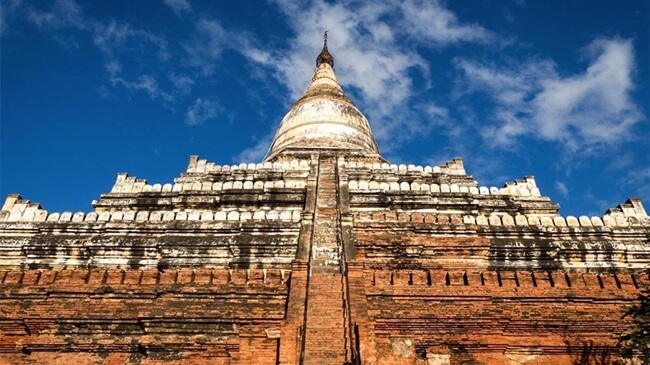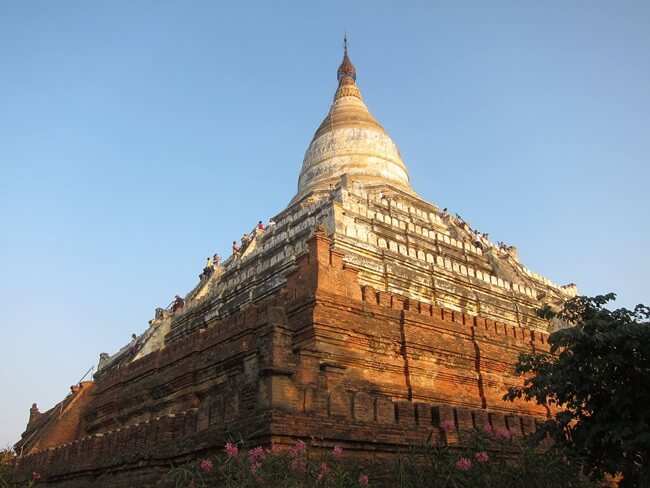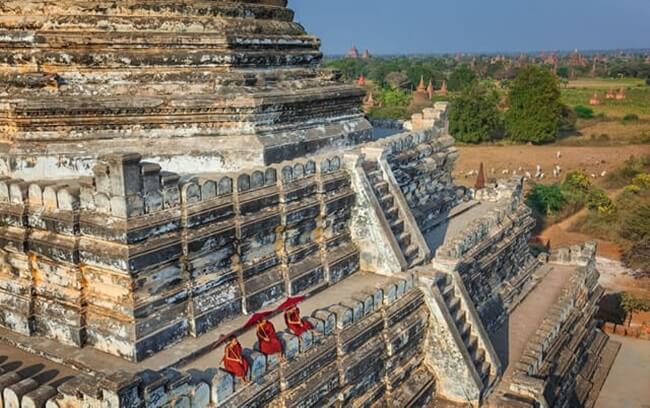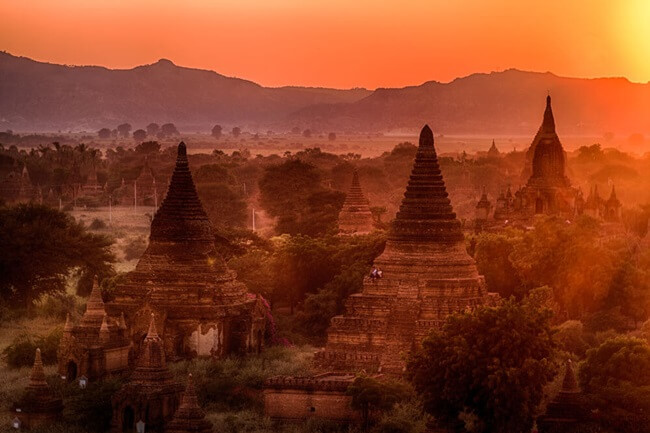Shwesandaw Pagoda – A “Guardian” of Ancient Bagan
13 Jun 2019 by Admin
Shwesandaw Pagoda is one of the highest pagodas in Bagan Plain. With the height of 328 feet and an imposing structure, the pagoda can be seen from far away and is an ideal spot for sightseeing in Bagan, especially at the moment of sunrise or sunset.

Shwesandaw Pagoda is One of the Highest Pagodas in Bagan
The History of Shwesandaw Pagoda
In accordance with the ancient tradition of Pyu, the Pagoda was located outside the walls of the ancient city of Bagan together with four other pagodas, including Shwezigon Pagoda, in order to create divine protection for Bagan City.

The Upper Half of the Pagoda was Whitewashed
The construction of Shwesandaw Pagoda started in 1057 A.D by the order of King Anawrahta, the founding father of Bagan Kingdom. King Anawrahta wanted to enhance Buddhism in his kingdom, so he asked King Manuha, who ruled the Mon Kingdom of Thaton, to give him a copy of Tripitaka, the teaching of Gautama Buddha.
Upon the refusal of King Manuha, King Anawrahta invaded Thaton. When returning from the Mon Kingdom, he brought with him hair relics of the Buddha and ordered the construction of Shwesandaw Pagoda to enshrine them.
In Burmese language, Shwesandaw means “golden holy hair”. In the past, the pagoda used to be named “Ganesh” or “Mahapeine” after the elephant-headed Hindu God guarding at the corners of the receding terraces who used to be worshiped in Bagan before the arrival of Buddhism.
The Architecture of Shwesandaw Pagoda
Shwesandaw Pagoda has a symmetrical design with a bell-shaped stupa rises from two octagonal pedestals placed on five square receding terraces. Until the early 50s of the twentieth century, Shwesandaw Pagoda still maintained its original design with just some minor repairs and maintenance.
In 1957, however, the Pagoda Management Board decided to modernize the temple by using limewash and plaster adornment on the upper half of the pagoda.

The Overal Structure of Shwesandaw Pagoda
The stupa is crowned with a gilded multi-tiered hti which is an ornamental spire in the shape of a ceremonial umbrella commonly encountered on temples and pagodas in Myanmar. The hti that we see today is just a replacement. The original hti was toppled by an earthquake in 1975 and is now displayed on the south side of the pagoda.

A Rare Moment Without Tourists on the Pagoda
The five receding terraces used to be covered with hundreds of terracotta plaques depicting the scenes in several Jataka tales about the previous lives of Gautama Buddha. Unfortunately, today tourists don’t have the opportunity to see them. During the restoration work in the 1990s, many bronze and stone Buddha images were found and they were moved to the Bagan Archeological Museum.
Sightseeing on the Top of Shwesandaw Pagoda
Thousands of tourists have chosen Shwesadaw Pagoda as the spot for capturing spectacular moments on Bagan plain, especially at sunrise or sunset. Many pictures of Bagan are taken from the top of Shwesandaw Pagoda.
Hence, since 2018, temple climbing in Bagan is banned for the safety of the tourist and the protection of the now UNESCO World's Heritage Site. Shwesandaw pagoda is still a spectacular monument and a must - visit temple in Bagan for its amazing architecture.
You can choose other options for watching sunrise and sunset in Bagan at the man - made mould or Bagan viewing tower located in the luxury Aureum Palace hotel. All provides great view of the temple plain.

Sunset on Bagan Plain
Contact us today to secure a cabin on our Luxury Myanmar Cruises taking you to the mystical plain of Bagan and other beautiful sites in Myanmar.











